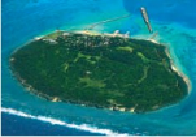Travel Reference
In-Depth Information
In a recent census, the island's population was recorded at 49, almost all of whom live
on the southern end of the island in the little village of Hatoma Port (
鳩間港
; Hato-makō).
The rest of the island is uninhabited and covered in scrub vegetation. There is a road/path
making a circle around the island but it's only partially paved. As is the case with so many
small islands in the Ryukyus, Hatoma's population has been declining for decades. It wasn't
all that long ago when there were several hundred residents. The tuna fishing industry was an
important source of income up until World War II and into the 1960s. Changing fish popu-
lations, changing patterns of modern life and changing expectations of young people have all
contributed to an overall decline in many such islands. Japanese Government officials have
essentially tried to “close” the island for some years, but diehard residents remain. Presently,
there's a public school up to junior high, but who knows how long that will last. Ultimately,
this island, along with many other very small islands, is destined to become uninhabited and
with that, a way of life will pass.
This aerial view of Kamijijima's sister islet Shimojijima shows its abandoned sugar cane fields.
An aerial view of oval-shaped Hatoma Island, with Hatoma Port at top (south), where its residents live.
Here's some good news: there are three
minshuku
on Hatoma and visitors are most wel-
come. All include meals in their rates, which is necessary because there are no restaurants on
the island. Hatoma, and the tiny inhabited islets like it, are perhaps the ultimate in a quiet


